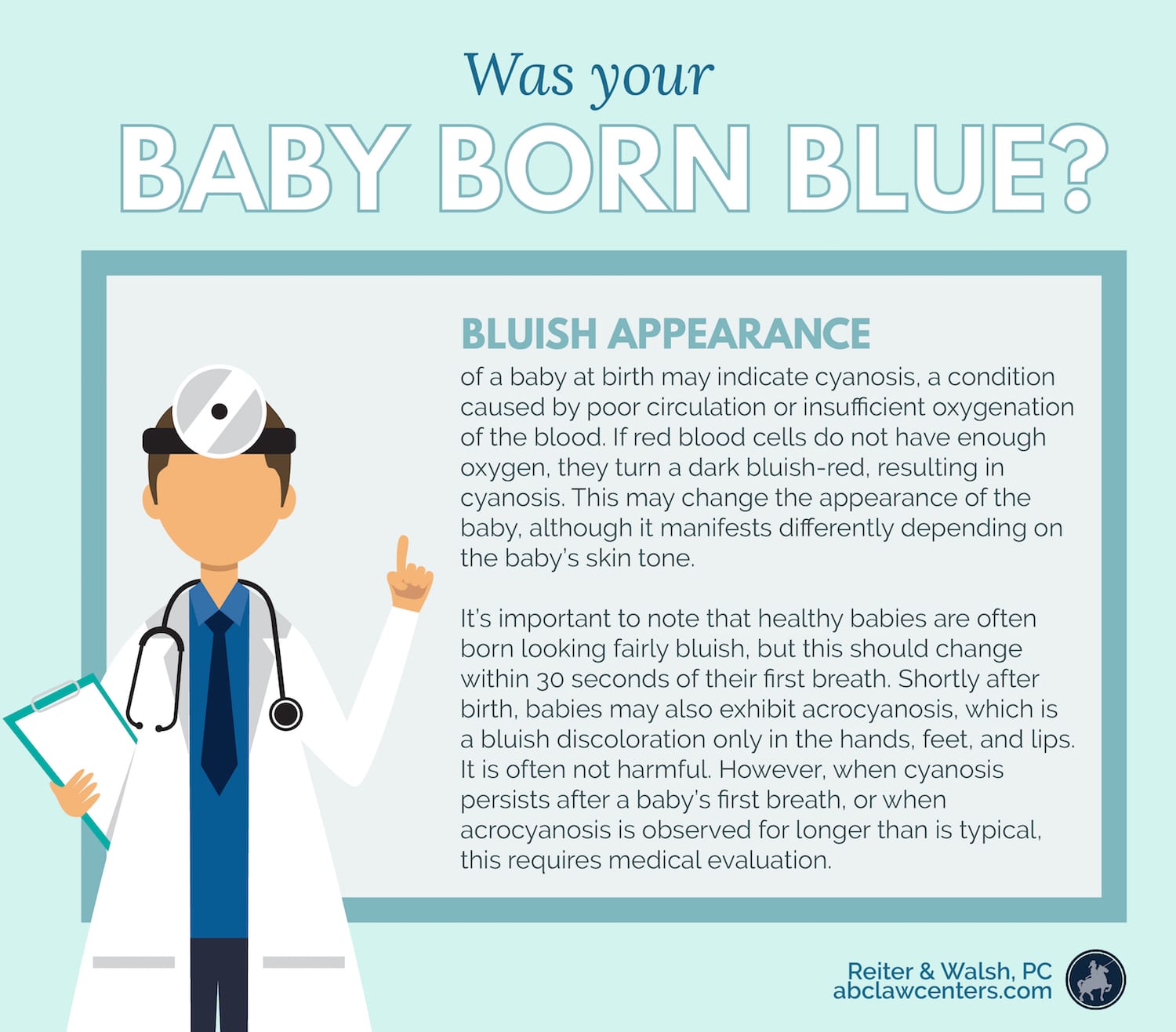My baby looks blue. Is this a sign of serious health issues?
If a baby looks abnormally blue, they may have cyanosis, a condition caused by poor circulation or insufficient oxygenation of the blood. Red blood cells transport oxygen throughout the body. When the red blood cells have a full supply of oxygen, they are bright red in color (hence the name). If they do not have enough oxygen, they turn a dark bluish-red, resulting in cyanosis (1). This may change the appearance of the baby, although it manifests differently depending on the baby’s skin tone. The skin of Caucasian babies may turn blue. For babies with darker skin, cyanosis may be more recognizable by looking at the mucous membranes (lips, gums, around the eyes) and the nails (1, 2). Cyanosis may affect the entire body evenly, or it may be more pronounced in certain parts of the body (such as the lower half, top half, or extremities).
It is important to note that healthy babies are often born looking fairly bluish, but this should change within 30 seconds of their first breath (3). Shortly after birth, babies may also exhibit acrocyanosis, which is a bluish discoloration only in the hands, feet, and lips (2, 4). It is often not harmful (2).
However, when cyanosis persists after a baby’s first breath, or when acrocyanosis is observed for longer than is typical, this requires medical evaluation.

What Are the Causes of Cyanosis?
Cyanosis can be caused by a variety of factors related to blood circulation and oxygenation. According to Saurabh Kumar Gupta (2015), clinicians can remember the main causes of cyanosis by using the acronym ABCD (Airway, Breathing, Circulation, and Defective hemoglobin):
A few examples of airway-related causes of cyanosis are choanal atresia (blockages in the nasal passage), craniofacial malformations, and laryngomalacia (a softening of the larynx, which lies above the vocal cords).
A few examples of breathing-related causes of cyanosis are meconium aspiration, pneumonia, and pneumothorax (lung collapse).
A few examples of circulation-related causes of cyanosis are persistent pulmonary hypertension of the newborn (PPHN), congenital heart diseases, and a low cardiac output state.
A few examples of conditions that might cause defective hemoglobin include methemoglobinemia, sulfhemoglobinemia, and hemoglobin M.
Miscellaneous causes of cyanosis include hypoxic-ischemic encephalopathy (HIE), apnea of prematurity, hypoglycemia, polycythemia, and sepsis.
It is important for doctors to determine the cause of cyanosis, because this will help them decide whether intervention is necessary, and if so, what form it should take (4, 5).
Management of Cyanosis in Babies
Because cyanosis can be a sign of many different health complications, it is important to address the underlying cause. In order to determine the underlying cause, doctors will need to perform an examination of the baby to test for respiratory problems, cardiac problems, neurological pathologies, and other potential issues (4).
Depending on what the underlying cause is, one or more of the following treatments may be warranted:
Surgery (for example to fix a heart problem)
Respiratory support (for example CPAP or mechanical ventilation)
Therapeutic hypothermia (this is a treatment for HIE, a type of brain damage that may occur when there is insufficient flow of oxygenated blood to a baby’s brain)
Treatment of infection (such as sepsis)
Medications or blood transfusions for hemoglobin-related issues
The aforementioned treatments are just a few examples of interventions that a baby with cyanosis may need. There are many more. Exact management plans and long-term outcomes for babies with cyanosis vary greatly depending on the underlying cause and other factors.
Cyanosis and Medical Malpractice
Doctors should quickly assess babies with cyanosis and provide the appropriate treatment (if needed). When a baby’s cyanosis goes unrecognized or the underlying causes are not promptly addressed, this is medical negligence. When this negligence harms the baby, it constitutes medical malpractice. In some cases, the underlying causes of cyanosis may also be due to malpractice (for example, if physicians fail to monitor a baby and do not recognize signs of fetal distress that could indicate asphyxia).
If your baby had cyanosis, and you believe medical malpractice was involved, the attorneys at ABC Law Centers: Birth Injury Lawyers may be able to help. Our award-winning lawyers have been representing victims of birth injury and neonatal malpractice for over three decades, and you pay nothing unless we win your case.
Sources
- Blue Discoloration Of the Skin: Medlineplus Medical Encyclopedia. https://medlineplus.gov/ency/article/003215.htm
- Simpson, Kathleen Rice., and Patricia A. Creehan. Perinatal Nursing. Lippincott-Raven, 1996.
- Richmond, Sam, and Jonathan Wyllie. “European resuscitation council guidelines for resuscitation 2010 section 7. Resuscitation of babies at birth.” Resuscitation 81.10 (2010): 1389-1399.
- Gupta, Saurabh Kumar. “Clinical approach to a neonate with cyanosis.” The Indian Journal of Pediatrics 82.11 (2015): 1050-1060.
- UpToDate, www.uptodate.com/contents/overview-of-cyanosis-in-the-newborn?search=cyanosis&source=search_result&selectedTitle=2~150&usage_type=default&display_rank=2.